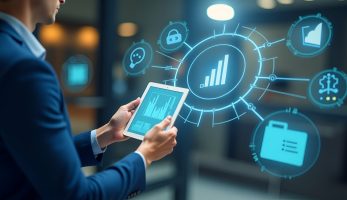Producing and managing content to support decision making is complex and outputs that drive opportunities often have a limited shelf life. Better visibility, effective communication and borderless collaboration is key to identifying and testing the right opportunities.
We have supported many leading organisations using our ‘Clarity by Davies’ platform, including our own, in delivering complex programmes of work at pace by building out a digital twin; something which would have been significantly more difficult using traditional tooling.
Why build a digital twin instead of using traditional methods?
There are several benefits of building your digital twin in a specialist platform over traditional tools, when modelling change and developing a business case.
Building a digital twin enables you to put aside disconnected diagram modelling and spreadsheet software to build out truly connected views and models of your organisation.
Collaboration: Digital twin software platforms enable multiple stakeholders to collaborate and work together on complex change initiatives in real-time, regardless of their location. This helps to improve communication, reducing errors and ensuring that all stakeholders are on the same page, supporting agile decision-making, problem solving and innovation.
Current vs future state: Digital twin software enables mapping of organisations, processes and functions with connected volumetric, organisational and operational metadata in a single interface, providing a seamless ability to test multiple options for change and produce complex analysis at the click of a button.
Simulation: Digital twin software platforms provide integrated simulation capabilities that enable organisations to quickly test and verify the performance of various real-world scenarios before actual implementation. This helps in choosing the right solution, anticipating and reducing risk, optimising performance, and creating new value streams.
Optimisation:Digital twin software platforms provide optimisation analysis tools that can help in identifying bottlenecks and inefficiencies in a process without relying on third party calculations. This helps in optimising the process flow for improving efficiency, and in identifying the right stakeholders and technology to support better outcomes.
Enterprise wide insights: a digital twin platform that can link multiple models can support wider transformation initiatives and intelligence gathering by providing a comprehensive and dynamic view of the organisation and its interactions “as a system”, enabling continuous improvement and innovation.
In summary: digital twin software platforms provide a powerful set of tools that enable businesses to model, optimise, and monitor change at both project and programme level, far more effectively than traditional tooling has allowed.
Creating a case for change
Using your digital twin to dynamically link maps and diagrams directly to volumetric, financial and operational data provides a unique opportunity to identify and test hypotheses for change without (often unwieldy) spreadsheets. Inbuilt transformation ROI, service level measures and other data outputs enable fast interrogation of information through reporting and visualisation tools.
Here are some of the key differentiators of a digital twin in creating a case for change:
Identifying a problem or opportunity: linked data within models helps quickly define a problem or opportunity, through inputting pain points, timings, roles, systems, locations and other related metadata relevant to a process or activity. These data can instantly be aggregated, filtered and exported to help prioritise key investment areas.
Testing and learning: changing elements in a model (and their associated metadata) to test impacts of change enables quick validation of hypotheses. It also provides an opportunity for alternative options to be modelled and compared at pace, with outputs detailing information such as cost and service impact available for analysis in just a few clicks.
Analysing the results: Model outputs can be analysed and calculated using the underlying engine to compare the potential effects of each change, enabling you to consider both the positive and negative financial, operational, and strategic impacts. This facilitates data driven decision making, and, as your digital twin grows, you can start to measure upstream and downstream impacts by linking data and models from other business areas, unlocking powerful insights.
Making decisions:summaries of the outputs of each change to a model can be quickly compiled with detailed explanations of their implications. Visualisations and other supporting materials can be compiled and extracted with just a few clicks to help communicate insights effectively, reducing risk to project timelines and enhancing business case building
Reusing outputs: once discovery in your process, function or business unit is concluded, future initiatives can be accelerated by leveraging these artefacts. This has been proven to reduce subsequent discovery phases by over 35%, and the models created during each product begin to build out into a framework which creates your digital twin, giving the organisation the opportunity to make more strategic decisions.

Our Group Digital Twin framework built in Clarity: unlocking wider opportunies with every new project we deliver.
Every new project added to your digital twin increases data maturity and enterprise business intelligence…
What you are hopefully beginning to see is that the power of a digital twin lies in the centralisation and connectedness of Operational Intelligence in a single platform.
Capturing more information with each new project and storing it in a relational database, supported by powerful, connected diagrammatic views enables organisations to reuse and compare information to support a broad range of initiatives; from simple process optimisation to rationalisation of roles and systems, identifying best practice and even comparing and optimising operating models of group companies.
The simplicity of creating a digital twin to safely model change reduces complexity, centralises key business information and provides an increasingly valuable resource for ongoing, highly effective transformation.
***
The focus of these first two articles has predominately focused on how building a digital twin can support reducing cost and improving service, faster and better.
However, a digital twin can also be used to enable businesses to measure and manage other key initiatives such as Operational Resilience, enterprise-wide GRC and much more.
This will be the focus of the next article.
Read the previous blog in this series.



